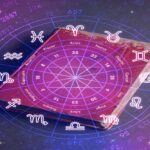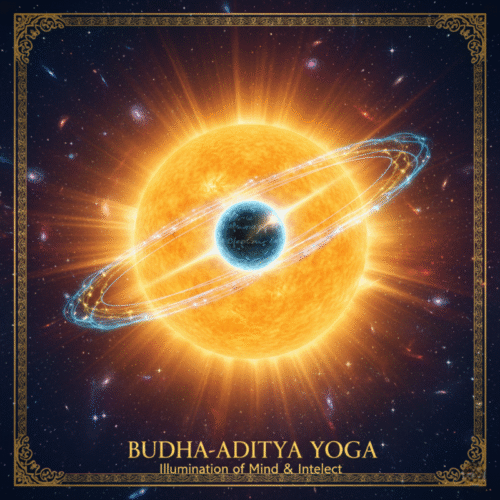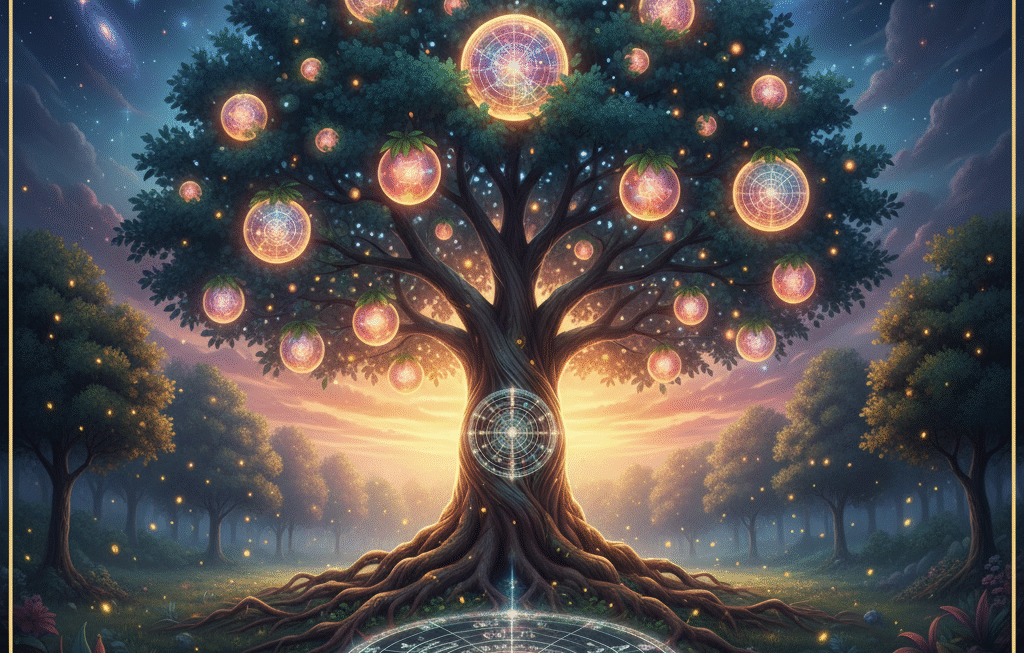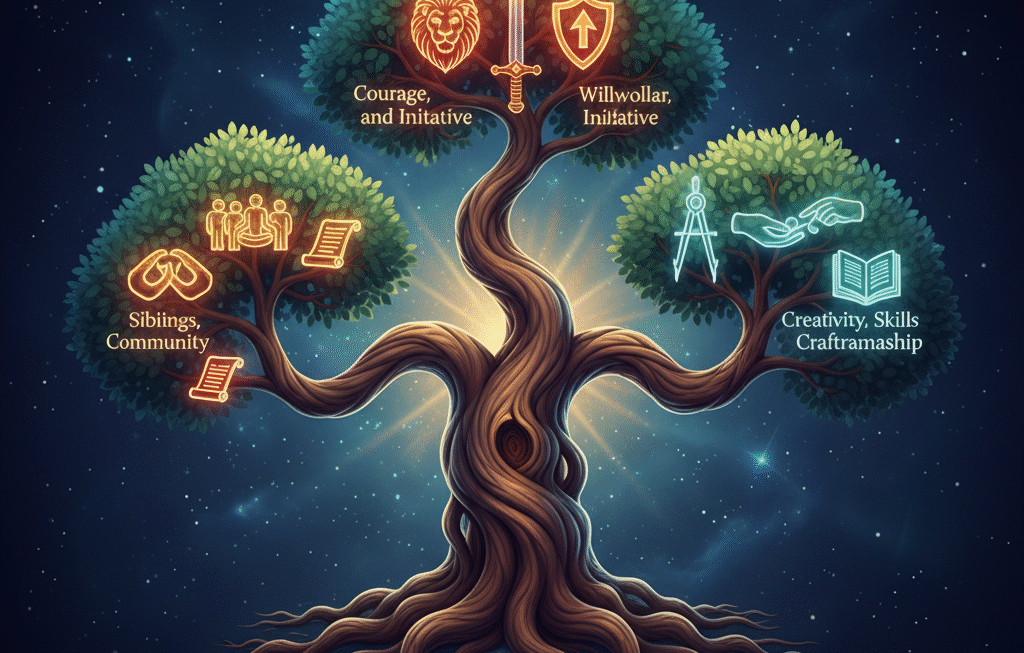What’s the astrological signature of a sharp intellect, skillful communication, and a mind destined for success? In the intricate language of Vedic astrology (Jyotish), such qualities often shine brightly when two specific planets join forces in the birth chart. This powerful alliance forms one of the most common yet significant combinations, known as Budhaditya Yoga.
Understanding this specific Yoga is key to recognizing the potential for brilliance, learning, and worldly achievement encoded within a horoscope. This exploration delves into the Budhaditya Yoga, explaining how this frequent Sun-Mercury pairing arises and, crucially, what determines whether it bestows profound intelligence or remains a latent potential.
Astrological Yogas: The Chart’s Deeper Dimensions
Before we focus on the specifics of the Sun and Mercury, let’s briefly touch upon the concept of Yogas. In Jyotish, a Yoga represents a special planetary combination formed through the placement, conjunction (association), or aspect between planets.
These planetary yogas are more than mere astronomical events; they are astrological circuits believed to shape the manifestation of planetary energies, leading to specific life outcomes. They are the underlying combinations in astrology that reveal possibilities ranging from great fortune (Dhana Yogas) to significant influence (Raja Yogas). Understanding these is essential for a nuanced chart interpretation.
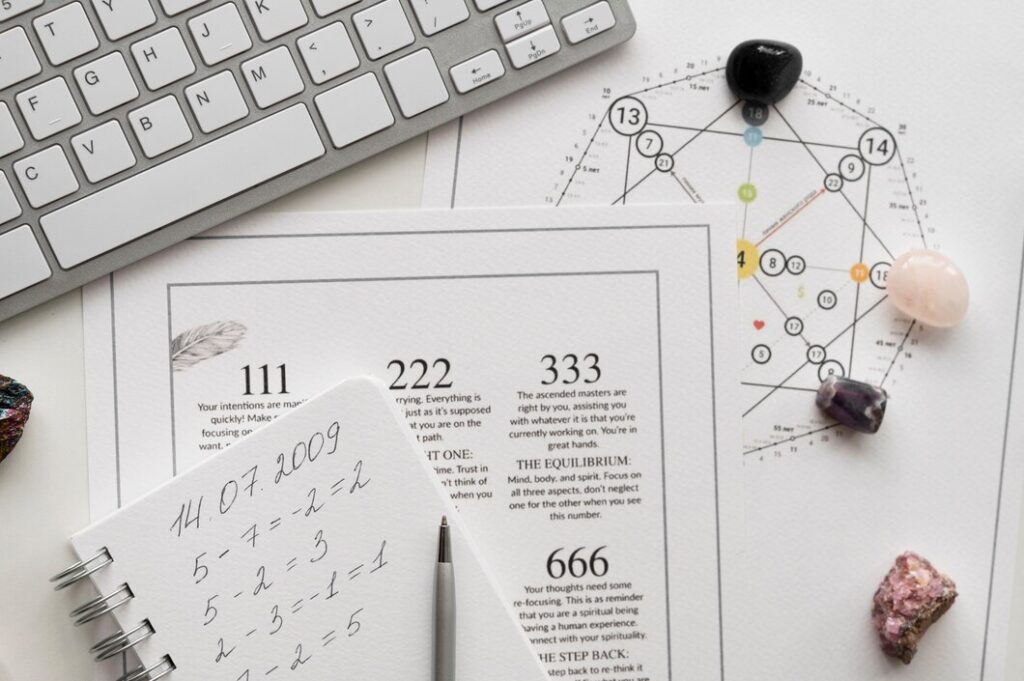
What is Budhaditya Yoga? The Union of Soul and Intellect
(Opinion): The Budhaditya Yoga is formed by the conjunction of the Sun (Surya) and Mercury (Budha) in the same house of a birth chart. It is primarily considered a yoga indicative of high intelligence, sharp intellect, strong learning capacity, skillfulness (especially with hands or communication), eloquence, and the potential for achieving fame, respect, and success through these mental gifts.
(Reason): Why is this specific conjunction considered so auspicious? The power of Budhaditya Yoga stems from the blending of the energies of the Sun and Mercury. The Sun represents the core self, the soul (Atma), authority, vitality, confidence, and purpose. Mercury represents the intellect (Buddhi), communication (Vak), analytical ability, learning, adaptability, skills, and commerce.
When these two planets are closely associated, the soul’s light and purpose (Sun) illuminate and empower the intellect and communicative abilities (Mercury). It suggests that the individual’s core identity is closely tied to their intelligence and how they express it. Mercury, being adaptable, takes on the Sun’s radiance, leading to brilliance, while the Sun gains articulate expression through Mercury.
(Example): An individual with a well-formed Budhaditya Yoga often exhibits a sharp, quick mind. They might be exceptionally skilled in fields requiring intellectual prowess, such as mathematics, writing, astrology, engineering, law, or strategic planning. They could be powerful orators, witty communicators, or possess great dexterity in crafts or trades.
Think of a brilliant scientist known for groundbreaking research, a persuasive lawyer winning complex cases, a skilled artisan creating intricate work, or even a clever merchant excelling in business. Their confidence (Sun) is backed by their intelligence (Mercury), making them effective and often respected.
(Opinion/Restatement): Therefore, Budhaditya Yoga is fundamentally an intelligence combo. It signifies the potential for the mind to shine brightly, fueled by the soul’s energy, leading to recognition and success primarily through intellectual or communicative pursuits.
Sun Mercury Conjunction: The Formation Rules
(Pattern Spotting): How do you identify this extremely common yet potentially powerful sun mercury conjunction in a birth chart? The formation rule is the simplest of all yogas:
Budhaditya Yoga is formed when the Sun and Mercury are placed together in the same house (sign) in the birth chart.
That’s it. If Sun and Mercury occupy the same compartment in your chart, the basic structure of Budhaditya Yoga exists.
Why is it so common? Mercury’s orbit is very close to the Sun. From our perspective on Earth, Mercury never appears more than about 28 degrees away from the Sun. Since each sign spans 30 degrees, this means Mercury is very often in the same sign as the Sun or in one of the adjacent signs. Therefore, a large percentage of birth charts will naturally feature this budhaditya combination. This very commonality leads us directly to the most critical part of analyzing this yoga: its strength and quality.
Sun Mercury Yoga: Interpreting the Results
(Value): What are the classical results attributed to a strong and well-placed Budhaditya Yoga? Vedic texts associate this sun mercury yoga with:
- High Intelligence (Buddhi): A sharp, analytical, and discerning intellect.
- Strong Learning Capacity: Ability to grasp concepts quickly and retain knowledge effectively.
- Skillfulness (Nipuna): Proficiency in various skills, often involving hands, calculations, or communication.
- Eloquence and Good Speech: Ability to articulate thoughts clearly and persuasively.
- Good Reputation and Fame: Earning respect and recognition due to one’s intellectual abilities or skills.
- Potential for Wealth: Financial success often achieved through intelligence, communication, trade, or specialized skills.
- Strong Character (influenced by Sun): Depending on the Sun’s strength, it can add confidence and authority to the intellectual expression.
- Interest in Arts and Sciences: A natural inclination towards learning and exploring diverse fields.
Essentially, this yoga suggests that the mind is a primary tool for navigating life and achieving success. The individual uses their intellect and communication skills effectively to make their mark on the world.
Mythbusting: Why Isn’t Everyone with Budhaditya Yoga a Genius?
(Engagement): This is where the “code-breaker” analysis becomes absolutely crucial, more so than for almost any other yoga due to its frequency. You will find this yoga in countless charts. So why don’t all these people display exceptional intelligence or achieve fame? The simple conjunction is merely the starting point. The actual manifestation of Budhaditya Yoga depends heavily on several critical factors, the most important being combustion.
- Combustion (Asta): THE MOST CRITICAL FACTOR: Because Mercury is always close to the Sun, it is very often “combust” or “Asta,” meaning it is too close to the Sun’s fiery rays and its significations are “burnt” or weakened.
- How it happens: Combustion occurs when a planet is within a certain number of degrees of the exact longitude of the Sun. For Mercury, this is generally considered to be within 12 to 14 degrees (though some astrologers use slightly different orbs, with closer proximity being more severe). If Mercury is within this range, it is combust.
- The Effect: A combust Mercury significantly damages the positive results of Budhaditya Yoga. The intellect (Buddhi) may become clouded, biased, or function erratically. Communication can be hampered, unclear, or prone to misunderstandings. Learning capacity might be reduced. Instead of brilliance, it can indicate flawed judgment or difficulty expressing oneself clearly. The closer Mercury is to the Sun (especially within 5-7 degrees), the more severe the combustion.
- Exception? Cazimi: A rare exception is when Mercury is exactly conjunct the Sun (within 1 degree, known as “Cazimi” or being “in the heart of the Sun”). Some traditions consider this exceptionally powerful, granting genius-level intellect, but it’s a point of debate and requires careful analysis.
- Check the degrees! You must check the exact longitudinal distance between the Sun and Mercury to assess combustion. This is the primary reason why many Budhaditya Yogas fail to deliver stellar results.
- Sign Placement (Rashi): In which sign does the conjunction occur?
- Mercury’s Strength: The yoga is strongest when Mercury is in its own signs (Gemini, Virgo) or exaltation sign (Virgo). It functions well in friendly signs (Taurus, Libra, Capricorn, Aquarius). It struggles in enemy signs or its debilitation sign (Pisces), where the intellect may become illogical or overly imaginative, even if Budhaditya is formed.
- Sun’s Strength: The Sun’s dignity also matters. An exalted Sun (Aries) adds immense confidence and leadership, while a debilitated Sun (Libra) weakens the vitality and authority aspect.
- House Placement (Bhava): In which house from the Ascendant does the conjunction occur?
- Kendra/Trikona (1, 4, 5, 7, 9, 10): Placement in these auspicious houses generally allows the yoga to manifest positively and prominently in core life areas (self, education, career, relationships, fortune). Budhaditya in the 1st gives intelligence focused on the self, in the 10th on career, in the 5th on creativity/learning.
- Dusthana Houses (6, 8, 12): If the conjunction occurs here, the results become problematic. Intellect might be used for conflict or dealing with health issues (6th), involved in hidden matters or research but also prone to sudden setbacks (8th), or focused on losses, expenses, or foreign lands, potentially leading to communication issues or mental isolation (12th). The brilliance might be obscured or used in challenging ways.
- Aspects (Drishti): Are other planets influencing the conjunction?
- Benefic Aspects: An aspect from Jupiter adds wisdom and ethical grounding. An aspect from Venus adds charm, artistry, and diplomacy to the communication.
- Malefic Aspects: Aspects from Saturn, Mars, Rahu, or Ketu modify the results:
- Saturn: Can make the thinking more serious, disciplined, and practical, but may also cause delays, pessimism, or overly critical communication.
- Mars: Adds sharpness, logic, debating skill, and technical ability, but can also lead to argumentative, sarcastic, or aggressive speech.
- Rahu: Can grant unconventional intelligence, skill in technology or foreign languages, and persuasive (even manipulative) communication, but also indicates potential for exaggeration or deceit.
- Ketu: Can bestow sharp intuition, mathematical ability, or skill in languages/coding, but may also cause abrupt speech, detachment, or difficulty in conventional communication.
- Navamsa Strength (D9): Are the Sun and Mercury strong in the Navamsa chart? Strength here confirms the innate quality of the planets, especially crucial if Mercury is combust in the Rasi chart.
Therefore, the commonality of the Budhaditya Yoga makes a nuanced analysis absolutely essential. A non-combust Mercury, strongly placed by sign and house, and receiving benefic aspects is the ideal for realizing the yoga’s full potential for brilliance and success. A combust Mercury, poorly placed or aspected, will likely give weak or even negative results related to intellect and communication.
Conclusion: The Potential for Brilliance
Budhaditya Yoga, the conjunction of the Sun and Mercury, is a ubiquitous feature in Vedic astrology charts, holding the promise of sharp intellect, effective communication, and skillfulness. It represents the powerful synergy between the soul’s purpose and the mind’s ability to express it.
However, its very frequency demands careful scrutiny. The “mythbusting” factors, particularly the crucial condition of combustion, along with sign, house placement, and aspects, determine whether this sun mercury conjunction truly manifests as a blessing of brilliance or remains a muted potential.
When well-formed and free from affliction, this intelligence combo is indeed a significant asset, equipping the individual with the mental acuity to learn, communicate, and achieve recognition. Understanding the specific conditions under which your Budhaditya Yoga operates is key to unlocking its true significance in your astrological journey.





